V-ing做主语和宾语
- 格式:ppt
- 大小:283.50 KB
- 文档页数:20
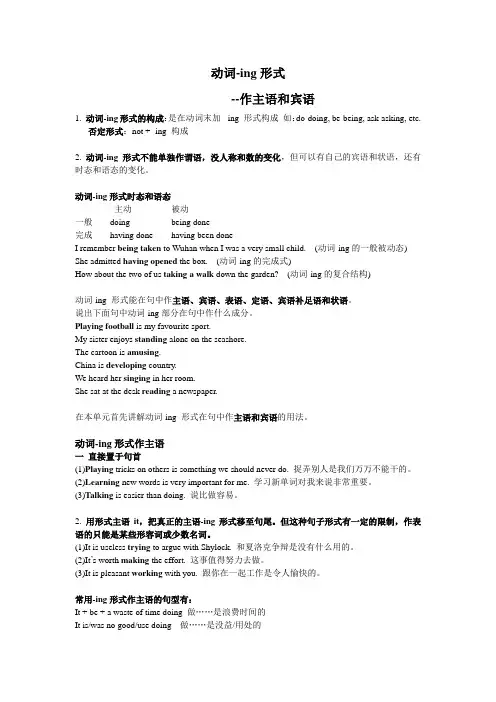
动词-ing形式--作主语和宾语1. 动词-ing形式的构成:是在动词末加-ing 形式构成如:do-doing, be-being, ask-asking, etc.否定形式:not + -ing 构成2. 动词-ing形式不能单独作谓语,没人称和数的变化,但可以有自己的宾语和状语,还有时态和语态的变化。
动词-ing形式时态和语态主动被动一般doing being done完成having done having been doneI remember being taken to Wuhan when I was a very small child. (动词-ing的一般被动态) She admitted having opened the box. (动词-ing的完成式)How about the two of us taking a walk down the garden? (动词-ing的复合结构)动词-ing 形式能在句中作主语、宾语、表语、定语、宾语补足语和状语。
说出下面句中动词-ing部分在句中作什么成分。
Playing football is my favourite sport.My sister enjoys standing alone on the seashore.The cartoon is amusing.China is developing country.We heard her singing in her room.She sat at the desk reading a newspaper.在本单元首先讲解动词-ing 形式在句中作主语和宾语的用法。
动词-ing形式作主语一直接置于句首(1)Playing tricks on others is something we should never do. 捉弄别人是我们万万不能干的。
(2)Learning new words is very important for me. 学习新单词对我来说非常重要。



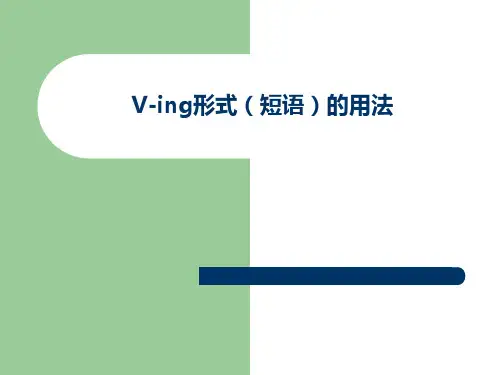
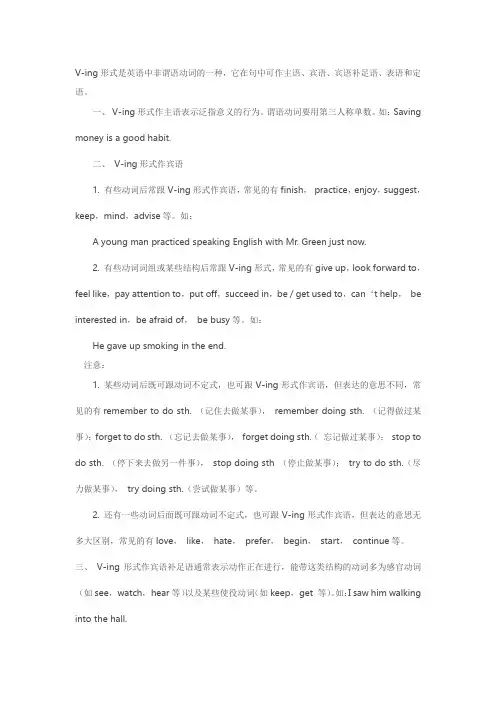
V-ing形式是英语中非谓语动词的一种,它在句中可作主语、宾语、宾语补足语、表语和定语。
一、V-ing形式作主语表示泛指意义的行为。
谓语动词要用第三人称单数。
如:Saving money is a good habit.二、V-ing形式作宾语1. 有些动词后常跟V-ing形式作宾语,常见的有finish,practice,enjoy,suggest,keep,mind,advise等。
如:A young man practiced speaking English with Mr. Green just now.2. 有些动词词组或某些结构后常跟V-ing形式,常见的有give up,look forward to,feel like,pay attention to,put off,succeed in,be / get used to,can‘t help,be interested in,be afraid of,be busy等。
如:He gave up smoking in the end.注意:1. 某些动词后既可跟动词不定式,也可跟V-ing形式作宾语,但表达的意思不同,常见的有remember to do sth. (记住去做某事),remember doing sth. (记得做过某事);forget to do sth. (忘记去做某事),forget doing sth.(忘记做过某事);stop to do sth. (停下来去做另一件事),stop doing sth (停止做某事);try to do sth.(尽力做某事),try doing sth.(尝试做某事)等。
2. 还有一些动词后面既可跟动词不定式,也可跟V-ing形式作宾语,但表达的意思无多大区别,常见的有love,like,hate,prefer,begin,start,continue等。
三、V-ing形式作宾语补足语通常表示动作正在进行,能带这类结构的动词多为感官动词(如see,watch,hear等)以及某些使役动词(如keep,get 等)。
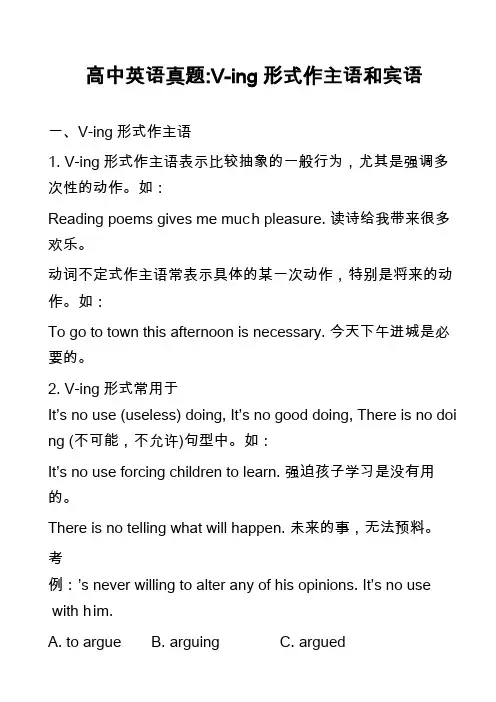
高中英语真题:V-ing形式作主语和宾语一、V-ing形式作主语1. V-ing形式作主语表示比较抽象的一般行为,尤其是强调多次性的动作。
如:Reading poems gives me muc h pleasure. 读诗给我带来很多欢乐。
动词不定式作主语常表示具体的某一次动作,特别是将来的动作。
如:To go to town this afternoon is necessary. 今天下午进城是必要的。
2. V-ing形式常用于It’s no use (useless) doing, It’s no good doing, There is no doi ng (不可能,不允许)句型中。
如:It’s no use forcing children to learn. 强迫孩子学习是没有用的。
There is no telling what will happen. 未来的事,无法预料。
考例:’s never willing to alter any of his opinions. It’s no use with h im.A. to argueB. arguingC. arguedD. having argued答案:B。
3. V-ing形式作主语,谓语动词用单数。
如:Learning new words is very useful to us. 对我们来说学习生词很重要。
二、V-ing形式作宾语1. 跟V-ing形式作宾语的动词有:spend, advise, allow, appreciate, avoid, consider (考虑), delay, enjoy, escape, excuse, finish, keep, imagine, mind, miss, permit, practise, risk, suggest 等及feel like, be fond of, what (how) about等固定词组。

![[精品]v-ing形式作主语](https://uimg.taocdn.com/49436b20a22d7375a417866fb84ae45c3b35c228.webp)
v-ing形式作主语、宾语和表语一、v-ing形式作主语1. v-ing形式作主语可放在句首,也可用形式主语it代替,常表示抽象动作或一般行为。
如:Using the right hand to shake hands is a convention in many countries. 用右手握手是许多国家的一种习俗。
It is no use complaining; the company won’t do anything about it. 抱怨是没有用的,公司是不会管的。
2. “名词所有格/形容词性物主代词+v-ing形式”构成复合结构也可以在句中作主语。
如:My being late made my mother very angry. 我迟到让我母亲很生气。
Susan’s winning the first prize excited us all. 苏珊获得一等奖使得我们大家很兴奋。
二、v-ing形式作宾语1. 有些动词后面要求跟v-ing作宾语。
类似动词有:admit, practise, appreciate, finish, avoid, consider, delay, enjoy等。
如:We often practice speaking English after class. 我们常常在课后练习说英语。
2.有些动词后面既可接不定式也接v-ing作宾语,但差别较大。
类似动词有:forget, remember, mean, try, regret, go on等。
如:She regretted having missed the film. 她懊悔没能看上那场电影。
I regret to say that we can’t stay here any longer. 我很抱歉,我们不能再在这儿多呆了。
3. 有些动词短语后也要求跟v-ing作宾语。
常这样用的动词短语有:can’t stand 忍不住;can’t help 忍不住;feel like 想要;give up 放弃;put off 推迟。
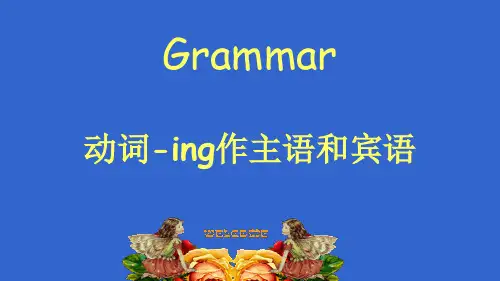
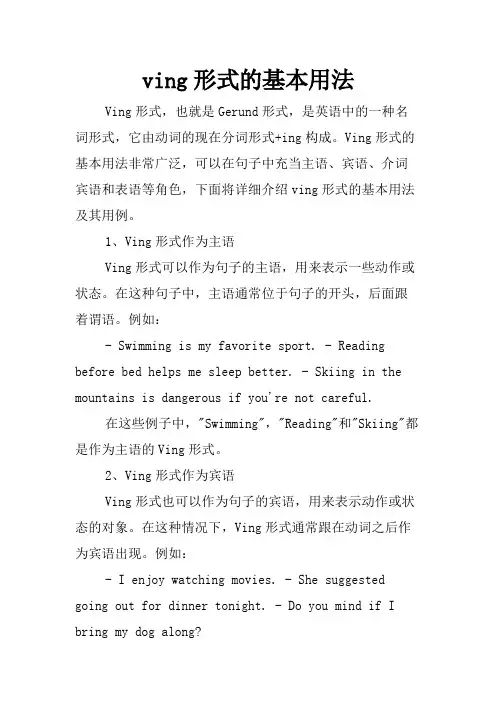
ving形式的基本用法Ving形式,也就是Gerund形式,是英语中的一种名词形式,它由动词的现在分词形式+ing构成。
Ving形式的基本用法非常广泛,可以在句子中充当主语、宾语、介词宾语和表语等角色,下面将详细介绍ving形式的基本用法及其用例。
1、Ving形式作为主语Ving形式可以作为句子的主语,用来表示一些动作或状态。
在这种句子中,主语通常位于句子的开头,后面跟着谓语。
例如:- Swimming is my favorite sport. - Reading before bed helps me sleep better. - Skiing in the mountains is dangerous if you're not careful.在这些例子中,"Swimming","Reading"和"Skiing"都是作为主语的Ving形式。
2、Ving形式作为宾语Ving形式也可以作为句子的宾语,用来表示动作或状态的对象。
在这种情况下,Ving形式通常跟在动词之后作为宾语出现。
例如:- I enjoy watching movies. - She suggested going out for dinner tonight. - Do you mind if I bring my dog along?在这些例子中,"watching","going"和"bringing"都是作为宾语的Ving形式。
3、Ving形式作为介词宾语Ving形式还可以作为介词的宾语,用来表示动作或状态的对象。
在这种情况下,Ving形式通常跟在介词之后作为介词宾语出现。
例如:- I'm looking forward to seeing the new Star Wars movie. - He's good at playing the guitar. - After finishing her homework, she went to bed.在这些例子中,"seeing","playing"和"finishing"都是作为介词宾语的Ving形式。